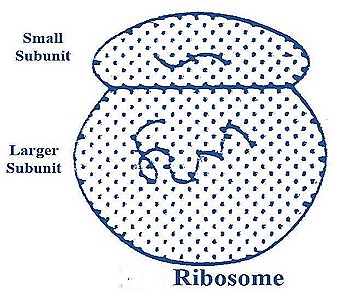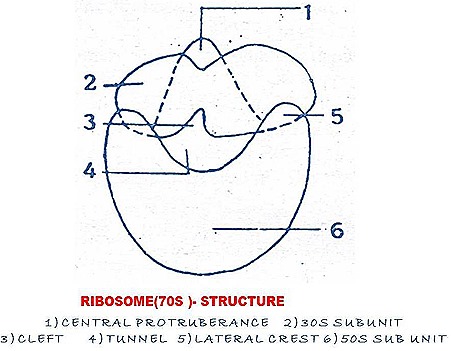RIBOSOMES -STRUCTURE - FUNCTION
Ribosome Structure Types And Functions
In 1949 Claude observed ribosomes and called them as microsomes. In 1955 Pallade named them as Ribosomes.
Occurance:
In both eukaryotic and prokaryotic cells the ribosomes are present.
Number:
The number of Ribosomes is directly proportional to the RNA content of the cell. In a liver cell of Rabbit 10s ribosomes are present.

Ribosomes are usually two kinds.
1) Ribosomes of prokaryotes are 70S type.
2) Ribosomes of eukaryotes are SOS type.
Each ribosome is made by two subunits, one is smaller and the other is bigger.
Association & Dissociation of the sub units :
At low concentration of Mg" the two ribosomal sub units remain united. If Mg" concentration increased by TO' times two ribosomes Unite and a dimmer is formed. If magnesium concentration much below then the ribosome divides into two sub-units.

A) Types of Ribosomes :
1) 70S ribosome : These are present in bacteria and prokaryotes. Such 70S ribosomes are also seen in mitochondria and chloroplasts of the cell.
2) 80S ribosome : They are present in eukaryotic cells. They are comparatively larger than 70S ribosomes.
3) 70S and 60S ribosomes: The mitochondrial ribosomes of fungi arc 70S type. But the mitochondria ribosomes of animal are 60S type. This was stated by "Levine" in 1974.

Chemical composition: Ribosome is made by RNA and proteins. Small amounts of lipids and metallic ions are seen in it. In SOS ribosome RNA content is 45% and protein content is 50%.
On dissociation of ribosomes different types of proteins and RNA will be resulted.
1) Ribosomal RNA: !n SOS ribosomes 28S, 18S, 5S RNA are present
a) 28S RNA is present in 60S subunit.
b) 1SS RNA is present in 40S subunit.
c) 5S ribosomal RNA is seen in 60S subunit. It has only 12 nucleotides. It looks like clover leaf.
2) Ribosomal proteins : Primary binding proteins are present in the sub units. On dissociation split proteins are liberated.
Ribosome structure:
1) Ribosome shows two sub-units,
-
Larger sub-unit.
-
Smaller sub-unit.
The larger sub-unit will be attached to endoplasmic membrane.
2)In between the smaller and bigger subunits a channel is present. The channel is parallel to the membrane of the endoplasmic reticulum.
3)In this channel the m RNA moves, m RNA is bond to the smaller subunit.
4)-t RNA will attach to the larger sub-unit
5)On the larger sub unit two sites are present.
a) P site: It is the site where polypeptide chain is attached.
b) A site: To this site t RNA will attach which will transfer its amino acid to the growing polypeptide chain.

6)The recent studies have shown that the two sub units of the ribosome' will exist freely in the cytoplasm. During protein synthesis the two subunits are united. After the protein synthesis the two sub units will be separated.
Biogenesis of ribosome:
In prokaryotic cells synthesis of ribosomes will take place in the cytoplasm.
In eukaryotic cells the synthesis of ribosomes is carried on by the nucleus.
1) Nucleolar organizing chromosomes will give rise to 28S and 18S RNAs.
2) In the nucleolar region 4OS RNA will be present. This gives rise to 28S and 18S RNAs.
3) This 45S nucleolar RNA molecules will get CH3 groups and these methylated molecules will unite with proteins. Thus 80S ribonucleo-protein molecule is formed. It is called RMP. (Ribonucleo protein molecule particle).
4) 45S RNA of 80S ribonucleoprotein molecule particle will split into 28S & 18S particle.
5) In the nucleus outside the nucleolus 5S r RNA will form.
6) 18S R RNA with proteins will come out of the nucleus and enter into cytoplasm. It associates with other proteins it becomes 40S sub unit.
7) The 28S r RNA & 5S r RNA with some proteins will enter into cytoplasm they give 60S sub unit.Thus ribosome is synthesized.
Functions :
-
Its main function is protein synthesis. With the help of m RNA, t RNA ribosome will produce new protein.
-
Many ribosomes are united with m RNA filament. It is called polysomes
-
They produce proteins.
